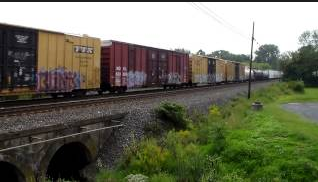Why isn’t rail used more to transport freight form Lower Mac warehouses?
Excellent question. One I get frequently. Most recent by an old friend on facebook. I thought I’d post the answer here since it’s a pretty common (and good) question. Every rail car takes a half dozen or more tractor trailers off the road.

Rail transportation is safer, more efficient and better for the environment than trucks. Reality though is, trains were never in play to service warehouses in Lower Mac. To ever say they were was misleading.
Why isn’t rail utilized more to transport freight in Lower Macungie? Afterall, this was one of the flawed reasons used by both the developer and then parroted by certain Commissioners in 2010 to justify the 700 acre negotiated rezoning from agriculture protection to largely industrial warehouses.
Here is the problem:
From the LVPC: (Lehigh Valley Planning Commission) – “The freight and freight-related business growth in the region has been significantly e-commerce and quicker turn around type companies (Amazon, Trader Joe’s for example). Since customers buying products from these companies expect 2-day or less delivery or the business deals in highly perishable goods, the longer time transfer rail lines are not viable to these companies.”
Basically, certain types of freight have a high percentage likelihood of being transported by rail. Others don’t. So, had Lower Macungie been serious about inducing rail usage leaders in 2010 could have negotiated assurances into the rezoning agreement guaranteeing it.
Most who opposed the 2010 rezoning understood rail was unlikely and that using it as justification for the re-zoning was lip service. (This was mentioned many times in public comments by those opposed, unfortunately as most followed closely understood the decision was already made.) Bottom line is pressure for these warehouses locally was always e-commerce and other types that exclusively use tractor trailers. So justification that properties had rail access made no sense and was in my opinion very much misleading.
To date there are ZERO rail sidings that will be built on “Jaindl” warehouses off Spring Creek Rd. In fact there isn’t a warehouse with current rail access in the entire township. There is one siding “ghosted” onto one new plan. But, there is a low likelihood it’s ever built.
Lastly, and ironically a material distributed at a very high percentage by rail is quarry rip rap. So essentially, Commissioners in 2010 took a proposed use (a quarry) where a significant portion of the output (rocks and materials) would generate a high likelihood of rail usage and they negotiated a different land use with literally zero likelihood of using rail.
Yes, a quarry has a numbers of negatives obviously. But traffic standpoint only, Commissioners in 2010 actually negotiated a far more traffic intense outcome.
